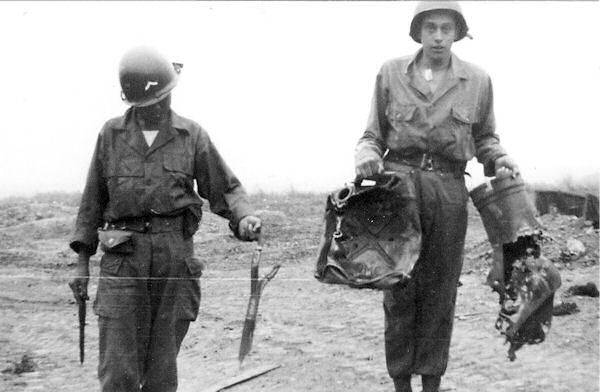
The Hancock-Henderson Quill, Inc.
(five part series by Monte Geddes, Mediapolis, Iowa formerly of La Harpe)
KOREAN WAR HEATS UP
The 98000 North Korean Invaders (KPA Korean People's Army) moved quickly south taking Seoul the South Korean Capitol.
The out manned, out gunned, South Korean Army (Republic of Korea Army ROK) fell back rapidly.
The first American forces to arrive was no match for the KPA but other American and British force arrived in time to hold at the Pusan Perimeter. Under intense attacks they held from August 4th to September 18, 1950.
General Douglas MacArthur the Commander in charge of all force changed thing fast. On September 15, 1950 a large force landed at Inchon on the west coast of Korea about thirty miles west and south of Seoul.
With our forces behind the KPA army attacking the Pusan Perimeter they had to get out fast. Thousands were captured and place in prison camps.
Our forces moved north very fast and on September 25, 1950 Seoul was back in our hands and the South Korean Government was again in business.
Our forces moved north fast and crossed the 38th Parallel and the North Korean Capitol of Pyangyang was captured on October 19th. MacArthur demanded that North Koreans surrender but that did not happen. Many of our leaders questioned our movement across the 38th and you can be assured the Chinese and Russians did also.
MacArthur believed in all out victory, like he had in WW-II but this was different and it ended with President Truman firing MacArthur on April 11, 1951.
MacArthur successor was General Matthew Ridgeway.
On November 1, 1950 with our forces looking down on the Yalu River dividing North Korea and China, the Chinese Army attack with an overwhelming force.
I have heard some veterans say that they looked down on open fields and a few minutes later there were so many Chinese that it looked like a forest.
Our retreat from the Yalu and the Chosin Reservoir area was probably one of the hardest action that U.S. forces ever had to take.
The cold was 40 below and equipment froze up and some had to be left behind.
I met a fellow in the hospital in California in 1952 that said he sat on a quad 50 all night and he could feel his feet freeze.
In the morning they could not get the thing to run and they blew it up and walked out.
He could not wear combat boots 16 month later or his feet would swell and turn black from low blood flow.
A good friend of mine Ron Carnes from La Harpe, spent his 17th birthday fighting his way out with the 1st Marine Division. He had lied about his age in order to join the Marine Corp.
Our forces fell back and established a defensive line and stopped the Chinese and KPA advance.
From that time on until now the MLR “Main Line of Resistance” has stayed about the same.
From west to east it runs in general along the 38th parallel until the west side of the Punchbowl and the line turns northeast to the east coast about 40 miles north of the 38th.
The last 30 months of the Korean War there were not many changes in the MLR. In fact many said that digging in and holding was much like World War One.
Many other nations contributed to the war with troops or medical supplies. British, Canadian, Australian, Turkish, Thailand, Philippines, Belgium, Columbia, Ethopia, France, Grease and the Netherlands contributed troops.
Norway, Sweden, Denmark, India and Italy sent medical units.
During this time back in the U.S.A. the draft continued, many reserve units from all branches of service and National Guard divisions were called into federal service to meet the demands for troops.
I think the general civilian population was in shock that we were so soon after WW-II, again at war.
Keep in mind our leaders called Korea a Conflict and was not called a war until 1993.
After over 54,000 American lives lost, most everyone thought it might be a war.
Probably Truman firing MacArthur was one of the most unpopular things that ever happened in history.
MacArthur was very popular and Truman’s action was not received very well at all.
Looking back on it now and reading what led up to it, I believe Truman had no choice and did the right thing.
Monte Geddes

June 6, 1953: On the night of June 5, 1953 C Battery received a lot of incoming.
The 4th Gun Section’s tool shed got hit with a 122mm incoming round. The next morning, “Moon” at KATUSA and I picked up tools and equipment. (Monte is on the right)